 Research Article
Research Article
An Extensive Study of Examination, Restoration, and Display of a Rare Historical Costumes, Practical Application
Harby E Ahmed1*, Mustafa Abu El Fadl2, Mohammed Kasem1 and Maisa M A Mansour1
1Conservation Department, Cairo University
2Supreme Council of Antiquities, Egypt
Harby E Ahmed, Associate Professor of Historical Textiles Conservation, Faculty of Archeology, Cairo University, 12613 Orman, Giza, Egypt.
Received Date: August 13, 2018; Published Date: August 29, 2018
Abstract
Historical clothing like Badawi’s tunic is a kind of three-dimensional textile. They are exposed to different types of damage as a result of various damage conditions such as faulty display, environmental conditions, air pollution, biological damage. For these historical clothing needs to intervene quickly restoration processes. In the past, there were erroneous repairs to the historical dress. Therefore, the first steps of restoration are to remove the previous faulty repairs. Tests were carried out using a Scanning electron microscopy, X-ray diffraction, infrared pattern to identify the type of fiber, the damage of the historical object. The stability of pigments was tested in the historical object. Mechanical cleaning was performed using different brushes. Also, wet cleaning using water and detergents. Also, sterilization and drying of the historical object.
The final installation of the historical piece was carried out as a prelude to the exhibits. All restoration steps are recorded by photograph.
Keywords: Historical clothing; Restoration; Fibers; Cleaning; Sterilization
Introduction
Textiles are part of our daily life now as much as in the past, from very early with human activities have been concentrated on the making of cloth and embellishing it for the purpose of keeping as warm and comfortable as possible, to show status- emperor, soldier, beggar man, thief- and to identify oneself. Many cultures of this world are still identified by their beautiful costume and textiles [1-5].
The historical textiles exposed to many challenges such as oscillate relative humidity (RH), changing temperature, and effect of light, effect of air pollution, non-standard storage and display methods. All these factors cause damage and decay in both fibers and dyes which results in weakness in fibers and dye, hardness in fibers, separate parts, loss parts, stain and dust [6-8].
The paper aims to present the [8] strategies for the conservation of historical textiles in Egypt. It shows new methods in the conservation of historic textiles, at least in Egypt. The paper aims at knowing the kinds of fibers and dyes, stain, dust, and different damages in this object through different ways of investigation. The paper reports the conservation treatment of the object such as cleaning, removing the old adhesive and old restorations, completing loss parts, fixing separate parts and making a new display.
Description of object
It is a coarse Cotton mantle with length is135cm. It is width at the shoulder 125cm, the height of sleeve 48 cm, the age of the mantle is more than 750 years old like the words which written at Almakrezy book Alsayed Ahmad Bn Ali Ibraheem Albadawy nicknamed “Alsayed.AL Badawi”, witnessed some events such as the battle of Ain Ghalot and he attended the fall of the Fatimid state and the emergence of the Ayyubid state in1250 AD. This mantle was found in the special room of Alsayed Albadawy and with an opening on the front with the length of the mantle. The original summer mantle and the newly summer mantles which their number is two.
I found the summer mantle down a number of layers It was put by the people and we have removed these layers in order to reach the original mantle. It was reached after two layers but was found to have some aspects of damage, such as stains that were found because of perfume. Also, has been established by some of the grubbiness that have become a suitable place for the growth of fungi and insects as well as the dust accumulated on them. All summer mantles are similar in color to red cotton, it is the same size and there is a slight difference in the opening of the mantle, the front is not decorated and does not bear writings.
Documentation and Examination
Visual documentation
The initial visual assessment revealed that the textile presented a poor conservation condition. The textiles were weak and very dirty since they covered with dust, soil and stains. In general, the object suffered from intensive surface damage resulting in fiber deformation, missing parts and holes especially along the objects edges. The fringes were weak and suffered from abrasive damage and tearing [9,10].
Optical and SEM documentation
The morphology of the surface of the wrapped cotton was investigated using Scanning Microscope (SEM) - a Quanta 200 ESEM FEG from FEI. Small samples taken and investigated under SEM to show the quality of the fibers as well as their damage aspects. SEM image showing the cotton fibers identified from different parts of the object. The fibers are extremely roughened, damaged, broken with transverse cracking and longitudinal splitting characterized by small scratches, small slits and holes. Furthermore, one can see the dust, dirt that covered the fiber [11-14].
Photograph documentation
High-resolution digital camera used for a documentation step. Photograph documentation used before, during, and after conservation process [15].
Testing the stability of dyes
Before starting the wet cleaning process. It is necessary to measure the sensitivity of dyed in the Historical mantle. Therefore, the colors are still when it is submerged in wet cleaning material that done by using small pieces of cotton. The cotton piece is wet and moved in a circular way over various areas of the mantle [16,17].
Restoration Process
Mechanical cleaning
Surface cleaning means various mechanical cleaning operations that are used to remove damaged cavities on the textile surface. They are often dust and sand, as well as the remains and residues of insects. This grubbiness is mechanically linked to textiles, as this grubbiness are inside in the spaces between the capillaries and some between the threads and some of them and the textile folds. Surface cleaning methods include brushes of various types, vacuum cleaners and air blowers, along with other hand tools such as fryer and mixers [18].
The wet cleaning procedure
In most cases mechanical cleaning is not enough to remove stains on the surface of the archaeological textile, so we go to used wet cleaning by water and detergents.
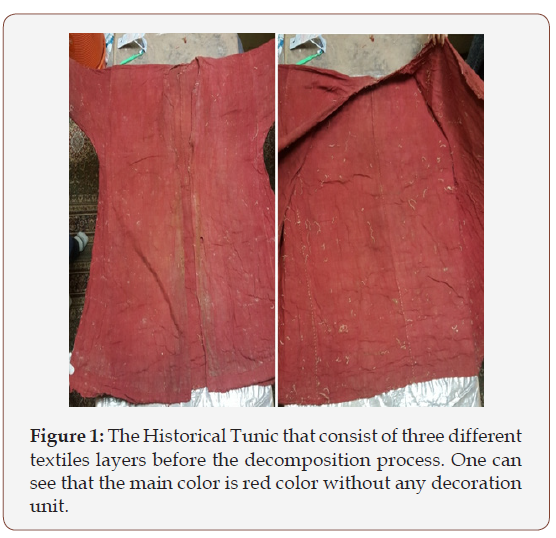
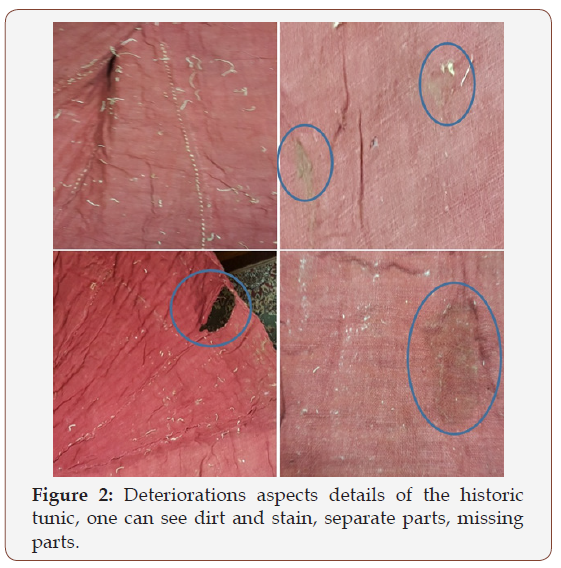
The choice of detergent is determined by the fiber and soil present in the fabric. pH indicator paper used to test the washing solution. Unless there is a possibility of damage, the textile is allowed to soak in the detergent solution for a period (15mintes). During these periods, enough solution is used to cover or submerge the specimen. This cleaning procedure used water with other detergent agents (Synperonic N), to increase the effectiveness of the cleaning process. The ratio was one-part detergent Synperonic N to 100 parts of distilled water. The water agitated by the hand to allow it to penetrate between the fibers to release the dirt particles, for 15 minutes. The bath temperature was 30oC in order to increase the effectiveness of cleaning. Then a second cleaning bath with distilled water only applied by the conservator for 10 minutes again with water agitation and then a third bath with distilled water only, for 10 minutes. It also reduced the soiling, relaxed the fibers, removed the creasing and brightened the colors [7, 8, 19](Figure 1-6).
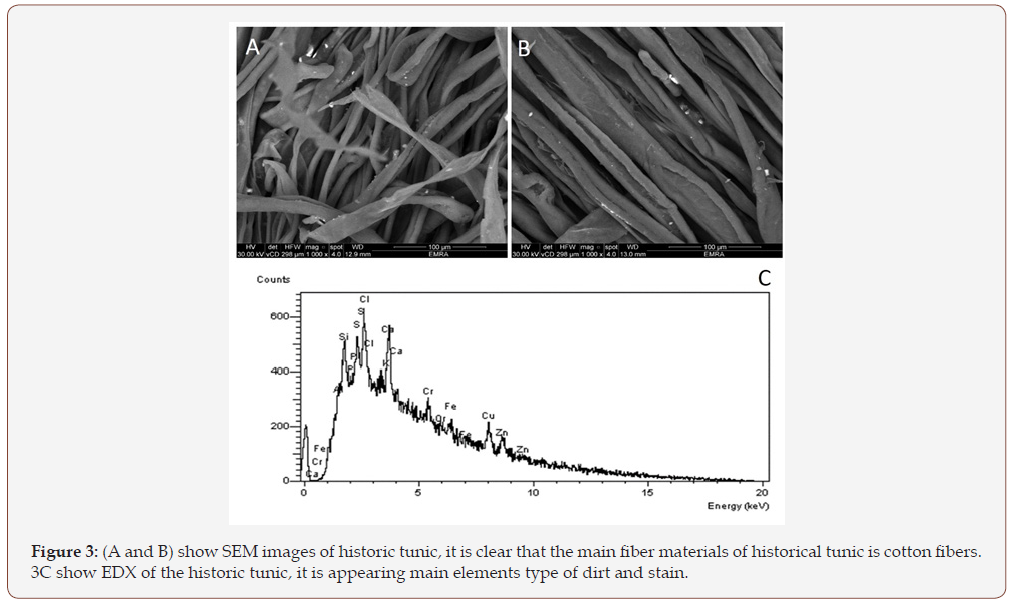
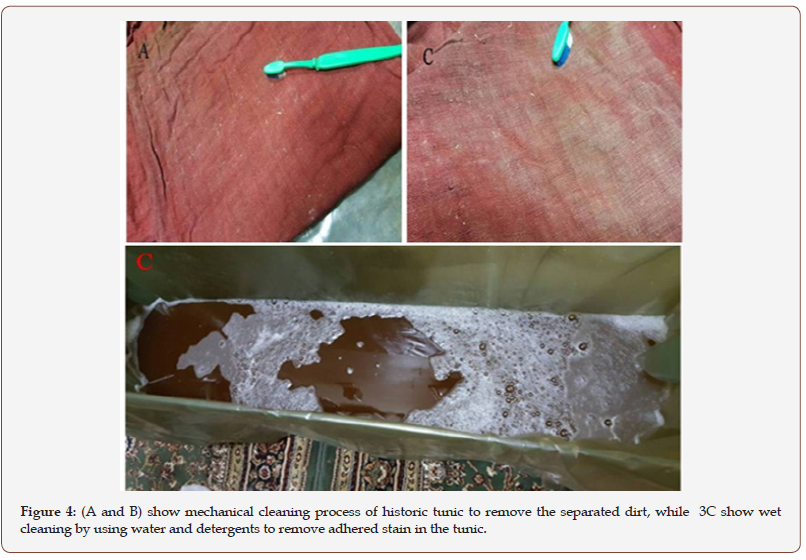
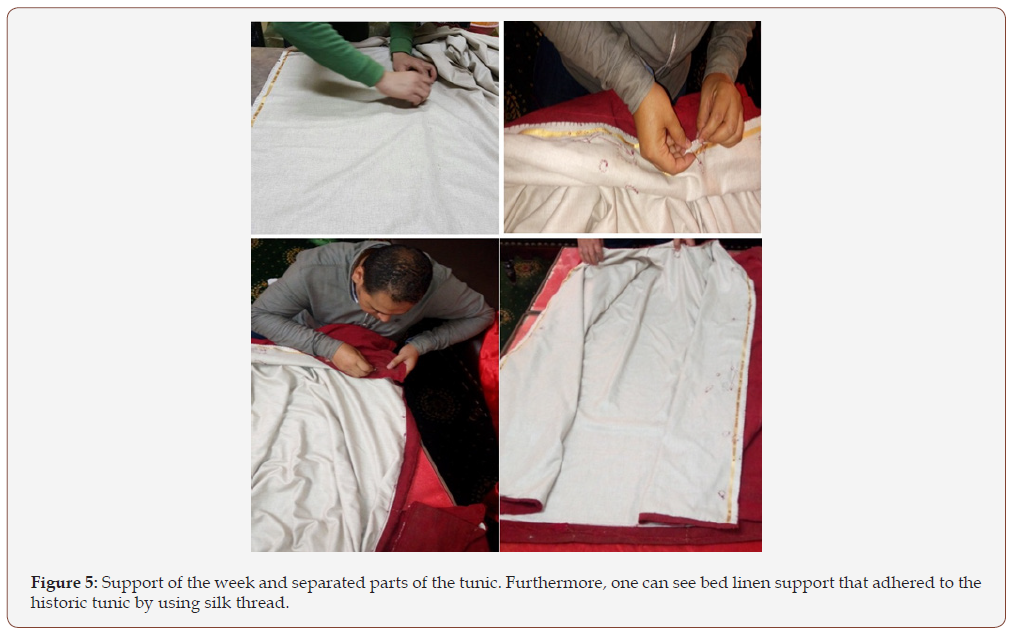
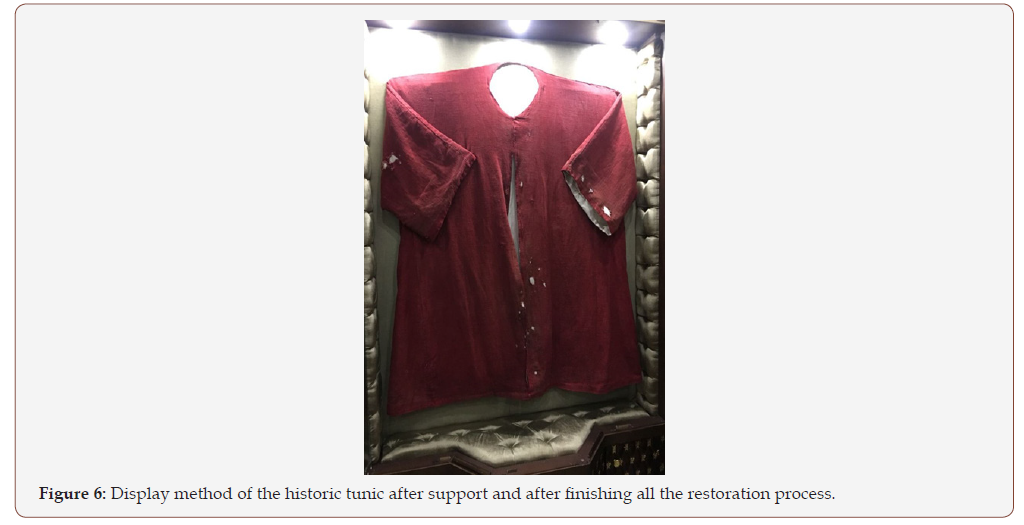
Drying process
The drying process of wet textiles can provide an opportunity to realign distorted fibers. The water acts as a lubricant reducing the stress of the fibers and allowing the straightening of the yarns with minimum risk. Blocking and drying considered a crucial part of wet cleaning process. To proceed with the next stage – drying – a table was prepared. Then, the textile pieces still wet from the wet cleaning placed on top of the table and covered with sheets of Japanese papers to absorb any water surplus [20, 21].
Final Support
A new linen support was prepared and washed well to remove chemical residues and prevent shrinkage later due to humidity changes. Then the new linen support was ironed to remove crease and was placed inside the historical shirt. Stitches were used with a very fine needle and fine silk thread to fix it into the tunic. In the beginning of the final stage, the edges of the tunic all around were attached by sewing with a small stitch technique (blanket stitch) and afterwards the edges of the missing and vulnerable parts were attached by small stitches. Similarly, sized stitches were used to attach the body of the tunic. The tunic could be displayed either on a mannequin made of inert material or on any other suitable threedimensional viewing system [16,22].
Conclusion
The article present restoring and maintaining historical tunic in environment uncontrolled museum. Scientific documentation processes using Visual documentation, Optical and SEM Documentation, X-ray diffraction analysis, testing the stability of dyes, and Photograph documentation. The documentation explained a lot of information about materials used in the manufacture of such textiles. This has helped in the development of the repair and maintenance plan as well as the selection of materials suitable for the restoration. Restoration and maintenance operations carried out on the historical piece.
References
- Ahmed H, Yahia D, Zidan Y (2018) Drestoration and storage procedures of a rare historical textile in the museum of the faculty of applied arts of Helwan university, Egypt. Egypt J Archaeological Restoration Stud 8(1): 35-43.
- Tímár-Balázsy Á, Eastop D (1998) Chemical principles of textile conservation. Routledge, Oxford, USA.
- Ahmed HE, Kolisis FN (2011) A study on using of protease for removal of animal glue adhesive in textile conservation. J Appl Polym Sci 124(5): 3565-3576.
- Ahmed HE (2009) History of natural dyes in North Africa ‘Egypt’. Bechtold T, Mussak R(Eds), Handbook of natural colorants, John Wiley and Sons, USA, p. 27.
- Landi S (1998) The textile conservator’s manual. Butterworth- Heinemann, UK, p.340.
- Ahmed HE (2014) A new approach to the conservation of metallic embroidery threads in historic textile object from private collections. Int J Conservation Sci 5(1): 21-34.
- Aslanidou D, Tsioptsias C, Panayiotou C (2013) A novel approach for textile cleaning based on supercritical CO2 and pickering emulsions. J Supercrit Fluids 76: 83-93.
- Barlow A (2016) Conservation of an early nineteenth-century blockprinted dress: techniques and historical importance. Fashion Institute of Technology, New York, USA.
- Elnagar K, Reda SM, Ahmed HE, Kamal S (2013) Studying irradiation homogeneity in light aging for historical textile conservation. Fibers and Polymers 14(9): 1581-1585.
- Fiette A (1997) Tapestry restoration: an historical and technical survey. The Conservator 21(1): 28-36.
- Batcheller, Jane C (2004) Optical and scanning electron microscopy techniques for the determination of hair fibers from Romano-Egyptian textiles. Scientific analysis of ancient and historic textiles: informing preservation, display and interpretation: postprints, first annual conference. London, United Kingdom, pp. 51-60.
- Down JL, MacDonald MA, Tétreault J, Williams RS (1996) Adhesive testing at the Canadian conservation institute: an evaluation of selected poly (vinyl acetate) and acrylic adhesives. Stud in conservation 41(1): 19-44.
- Nassef OA, Ahmed HE, Harith MA (2016) Surface and stratigraphic elemental analysis of an ancient Egyptian cartonnage using laserinduced breakdown spectroscopy (LIBS). Anal Methods 8(39): 7096- 7106.
- Ahmed HE, Nassef OA (2013) From Ptolemaic to modern inked cotton via laser induced breakdown spectroscopy (LIBS). Anal Methods 5(12): 3114-3121.
- Ahmed HE (2011) Strategy for preservation of ptolemaic wrapped mummy’s linen in tuna el-gebel excavation, Egypt. A case study. Int J Conservation Sci 2(3): 155-164.
- Ahmed HE, Gremos SS, Kolisis FN (2010) Enzymatic removal of the oily dirt from a coptic tunic using the enzyme lipase. JTATM 6(3): 1-17.
- Ahmed HE (2013) Identification and conservation of a rare islamic textile decorated with metallic yarns. Egypt J Archaeological Restoration Stud 3(1): 39-45.
- Ahmed HE (2012) First aid of rare Ptolemaic textile in Tuna el-Gabel Excavation, Egypt. e‐conservation 2: 81-90.
- Quye, Anita, Lennard F (2015) Materialising conservation science research for historical textiles. International Conference on Science and Engineering in Arts, Heritage and Archaeology (SEAHA), London, UK.
- Marincas O, Grigoriu A (2002) Conservation of post-byzantine textiles. Improvement of their preservation conditions and accessibility to citizens–the first results of a local Romanian project. Workshop 4: 324- 327.
- Mason TJ (2016) Ultrasonic cleaning: an historical perspective. Ultrason Sonochem 29: 519-523.
- Pow CV (1970) The conservation of tapestries for museum display. Stud conservation 15(2): 134-153.
-
Harby E A, Mustafa A E F, Mohammed K, Maisa M A M. An Extensive Study of Examination, Restoration, and Display of a Rare Historical Costumes, Practical Application. J Textile Sci & Fashion Tech. 1(2): 2018. JTSFT.MS.ID.000506.
-
Historical clothing, Restoration, Fibers, Cleaning, Sterilization, Textile, X-ray diffraction, Dye, Restorations, Sleeve, Mantles, Cotton, Bear writings, Abrasive, Conservation, Mechanical cleaning, Air blowers, Fabric, Sized stitches
-

This work is licensed under a Creative Commons Attribution-NonCommercial 4.0 International License.






